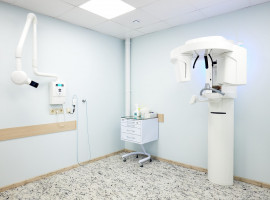A Quick Out-Patient Sedation Leads to Long-Term Problems
Case Study
Marc Leffler, DDS, Esq.
March 15, 2022
Reading time: 7 minutes

Background
On referral from her general dentist, a healthy 31-year-old female civil engineer (“Ms. B.”) presented to a solo practitioner oral and maxillofacial surgeon (“Dr. K.”) with ongoing discomfort associated with her soft-tissue impacted upper left third molar. Radiographic and clinical examination revealed the impacted tooth to have a conical root, and the gingival tissue overlying it was inflamed. Ms. B. accepted the surgeon’s recommendation of extraction, but preferred to be “under” for the procedure. Dr. K. prescribed an antimicrobial oral rinse and scheduled the extraction for the following week.
The patient came for surgery with her friend, who would drive her home following treatment. She was NPO for nearly 10 hours. Once in the treatment room, vital signs were noted to be stable, so a nasal mask was placed for delivery of N2O/O2 and a 25 gauge butterfly was inserted into the right (dominant) antecubital fossa, resulting in venous blood return. The IV needle was taped in place, a Luer-Lock syringe containing Propofol was attached, and the patient’s arms were placed by her sides.
A bite block was placed and a bolus dose of Propofol was slowly injected intravenously, followed by an additional amount less than a half-minute later. Ms. B. was very shortly “asleep” and breathing regularly, at which time Dr. K. injected local anesthesia buccally and palatally. A soft tissue crestal incision was made, a flap was raised, and a straight elevator was placed interproximally, with force delivered against the tooth. At that point, the patient suddenly began to move her head and raise both hands to her face. Dr. K. placed gauze next to the surgical site and worked with his chairside assistant to place the hands next to the patient’s body, noticing that the IV needle had come out during the struggle. Once the patient stopped moving, additional local anesthesia was given, the tooth was removed uneventfully, and the site was sutured. Ms. B. rested in the office recovery room until she was fully awake, and left with her companion and a set of post-operative instructions.
The following morning, the receptionist called Ms. B., as was office policy. The patient said that the IV site was red and painful, to which the staff member responded, “That’s normal, don’t worry, we’ll see you in a week.” A chart entry of “called patient, all ok” was left on Dr. K’s desk for him to review. At the 1-week suture removal visit, Dr. K. noted the IV site to be “red, hard, difficult to bend elbow, burning pain, generally inflamed”. He advised warm compresses, an NSAID, and movement exercises, and asked the patient to return “as needed”. The patient never returned to Dr. K.
However, without any resolution of her arm problem, with pain actually worsening and spreading, Ms. B. sought the care of a specialist in physical medicine and rehabilitation, who began a course of manipulative therapy. This provided minimal, if any, relief, and the patient found it more and more difficult to concentrate and perform her work functions, and was entirely unable to continue playing in her weekly softball game. She consulted with a pain management specialist, an orthopedist, a physical therapist, and two neurologists; each instituted a course of treatment, including an array of medications, but the condition remained essentially unchanged. Finally, a diagnosis of Complex Regional Pain Syndrome—formerly known as Reflex Sympathetic Dystrophy—was made.
Legal Action
Ms. B. became a plaintiff after retaining an experienced malpractice attorney, who sued Dr. K. on her behalf. The thrust of the claim initially appeared to be that Ms. B had suffered a significant loss in the quality of her life, as a result of the ongoing pain and reduction in her arm function. However, the attorney brought in a life care planning expert who, in conjunction with one of the plaintiff’s treating doctors, produced a set of opinions which would be critical to the potential case value in litigation: Ms. B. would not for much longer be able to effectively perform her work functions, which included hands-on interactions at building construction sites, thereby inhibiting her upward career path, so she would ultimately suffer a significant reduction in her income, for as long as she would continue to work.
The suit also included a claim for lack of informed consent, based upon the consent form she signed containing only surgical risks and “injury at IV site”, and the patient’s assertion that there was no discussion of any specific risks associated with the IV procedure, with nothing about any potential permanent effects in that regard.
Case Defense Steps
When Dr. K. reported to his malpractice carrier that he was served with papers, he was quickly assigned legal counsel, who reviewed the surgical and anesthesia charts, gathered medical records, and spoke with Dr. K. at length. With the understanding that much would still be discovered as the case moved forward, the attorney consulted with well-credentialed experts in oral surgery/anesthesia and neurology, in order to get an early general sense of whether the treatment comported with the standard of care, and whether the injuries claimed were foreseeable from, and caused by, the events at hand.
After reviewing all of the records from the subsequent treaters, the neurologist concluded that there was no other potentially precipitating event that could have caused the patient’s complaints, that her complaints seemed genuine and consistent with each other, and the diagnosis established was well-founded and likely permanent in nature. The oral surgery/anesthesia expert, who regularly teaches students and residents, opined that the standard of care dictated that Dr. K. should have prevented the patient’s arm—with the IV in place—from moving as it did, and this could have been accomplished simply by lightly strapping the wrist to an arm board.
Dr. K. and his attorney discussed the views of the experts, albeit initial, with Dr. K acknowledging that he did not appear to have a solid explanation for why he did not take that protective step. He willingly agreed to his attorney’s recommendation that an attempt be made to settle the case early, so as to try to reach a settlement that would be of lesser value than if the case proceeded through the typical litigation process, which would necessarily require the plaintiff and her attorney to expend large sums of money which they would then seek to recover. Settlement discussions ensued between the attorneys, leading to a resolution which was of far less monetary amount than even Dr. K. thought it would be.
Takeaways
In order for a plaintiff to be successful in a malpractice suit, they must prove, through expert opinion testimony, that there was injury caused directly by some departure from the standard of care. It is for this reason that the defense attorney needed to consult with experts regarding both liability and causation of injury before completing the initial legal assessment as to whether the plaintiff’s case was viable. Concerning the basis for a cognizable claim for lack of informed consent, many jurisdictions simply require that a patient was not provided with adequate information before an invasive procedure, which information would have allowed the patient to make an informed decision, and that the invasive procedure—even if done in conformity with the standard of care—caused the injury claimed.
So, while practitioners may view the informed consent process as less important than the surgery itself, the failure to engage in it meaningfully can often lead to an easier path for a plaintiff to recover. Here, the informed consent process lacked the detail that would have been expected to demonstrate that the patient was an educated consumer before she permitted the anesthesia process to go forward. Because a plaintiff will be successful by proving even one of her claims—a negligent procedure or lack of informed consent—Dr. K.’s experts would have to have been able to defend his actions for both claims in order for him to prevail.
Addressing the claimed damages, CRPS is fairly uncommon, and its cause is not clearly understood, but it is known to occur after an injury (generally to an arm or leg), among other mechanisms. A feature often found is pain which is out of proportion with the severity of the initial injury; that aspect of the condition does not negate the validity of the legal claim, despite the exaggerated manifestations. Finally regarding the injury, there is at least anecdotal evidence that CRPS patients do better when treatment is started early.
To that point of beginning treatment for CRPS early, the seemingly innocuous interaction between the office receptionist and Ms. B. might have decreased the prospects for a better injury outcome, by delaying such treatment, if only for a week. When the patient voiced a complaint relating to the IV site on the first post-op day, the medically untrained staff member provided what amounted to medical advice, without consulting with the oral surgeon, and furthered the issue by incorrectly reporting in the chart (and to Dr. K.) that everything was “ok”, although it was not (in the eyes of the law, Dr. K. was responsible for the actions of his employee.) When Dr. K. saw the patient the following week, he determined that there was a problem and initiated a course of care, but left it to the patient’s discretion to return to see him “as needed”, rather than scheduling a definitive assessment at a later date. In doing so, he lost the opportunity to maintain some level of control over the course of progress of an undesired result, and to keep an ongoing line of communication with his injured patient.
Note that this case presentation includes circumstances from several different closed cases, in order to demonstrate certain legal and risk management principles, and that identifying facts and personal characteristics were modified to protect identities. The content within is not the original work of MedPro Group but has been published with consent of the author. Nothing contained in this article should be construed as legal, medical, or dental advice. Because the facts applicable to your situation may vary, or the laws applicable in your jurisdiction may differ, please contact your personal or business attorney or other professional advisors if you have any questions related to your legal or medical obligations or rights, state or federal laws, contract interpretation, or other legal questions.
Additional Risk Tips content

Surgeon’s Audio Records Reveal Flaws In Informed Consent Process
Oral surgeons who record patient visits should be cautious. Learn how a dentist's own audio records proved detrimental in a malpractice case.

Oral Surgeon Sued by Elderly Patient’s Healthcare Proxy
Oral surgeons must consider patient autonomy. Read a malpractice case about a surgeon who listens to the wants of the healthcare proxy instead of the patient.

Patient with Permanent Nerve Injury Sues OMS for Not Using CBCT
Read about a patient who suffers a permanent IAN injury post-extraction and sues the OMS for failing to use a CBCT to assess the injury beforehand.
This document does not constitute legal or medical advice and should not be construed as rules or establishing a standard of care. Because the facts applicable to your situation may vary, or the laws applicable in your jurisdiction may differ, please contact your attorney or other professional advisors if you have any questions related to your legal or medical obligations or rights, state or federal laws, contract interpretation, or other legal questions.
MedPro Group is the marketing name used to refer to the insurance operations of The Medical Protective Company, Princeton Insurance Company, PLICO, Inc. and MedPro RRG Risk Retention Group. All insurance products are underwritten and administered by these and other Berkshire Hathaway affiliates, including National Fire & Marine Insurance Company. Product availability is based upon business and/or regulatory approval and/or may differ among companies.
© MedPro Group Inc. All rights reserved.